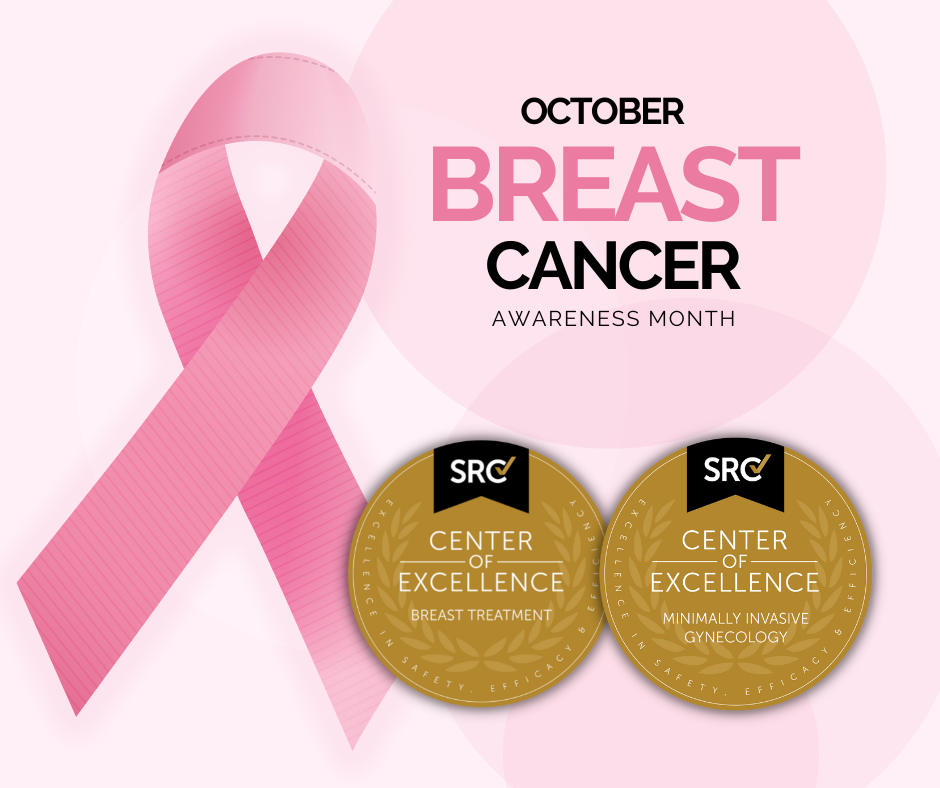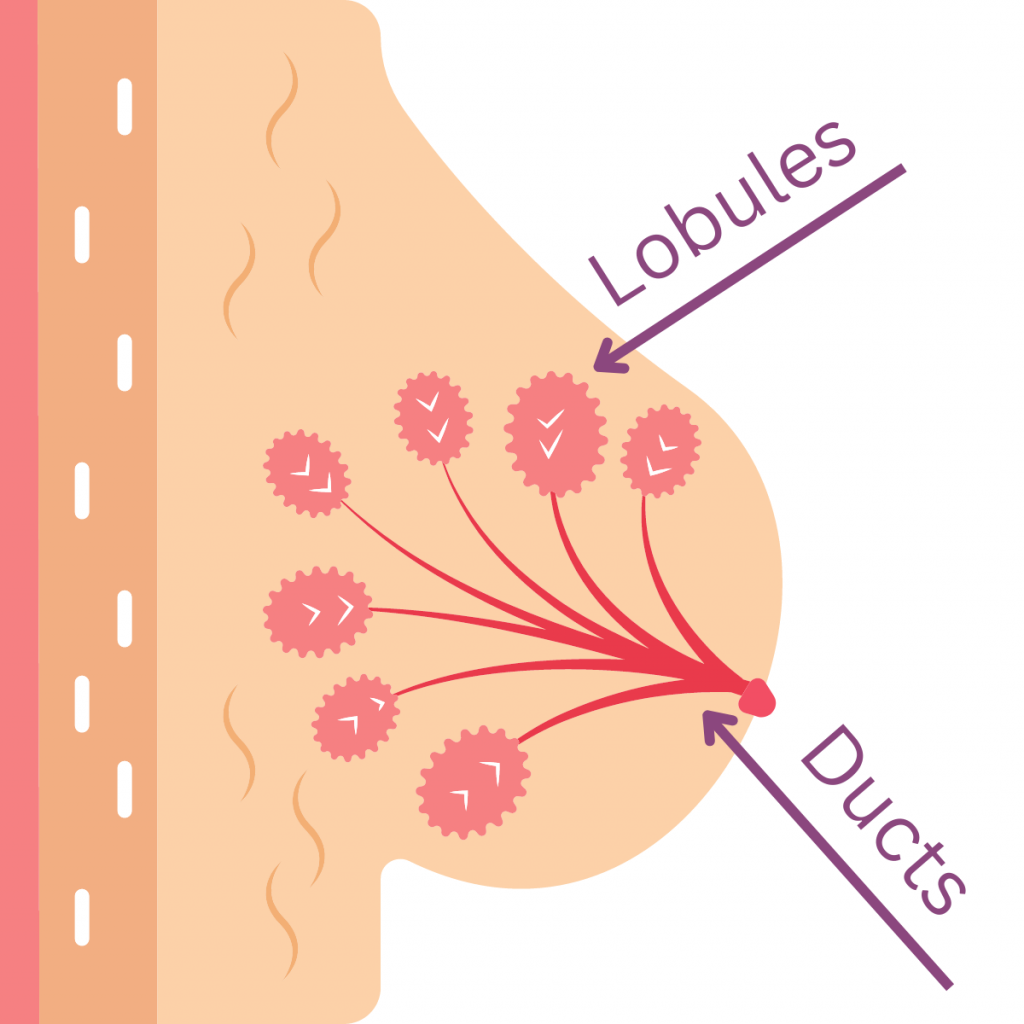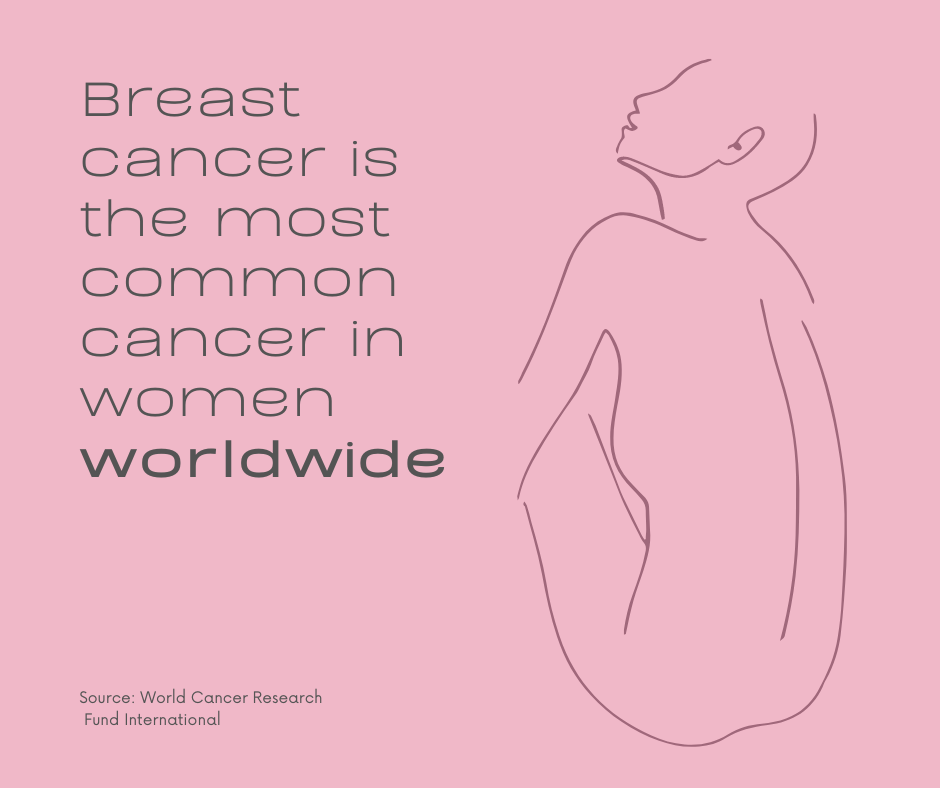
October is Breast Cancer Awareness month. According to the CDC, approximately 264,000 US women and 2,400 US men are diagnosed with breast cancer every year. We wear pink this month to raise awareness of breast cancer and the importance of early detection methods such as self-screening and annual mammograms beginning at age 40 – 45 for most women.
As defined by the CDC, breast cancer occurs when there is an uncontrollable growth of cells in the breast. There are different forms of breast cancer which are determined by the type of cells within the breast that turn cancerous. Three main parts make up the breast: lobules – the milk-producing glands, ducts – the tubes that transport the milk to the nipple, and connective tissue which is both fibrous and fatty that hold everything together. The most common place for breast cancer to begin is in the ducts or the lobules.
While there are several forms of breast cancer, the two most common are infiltrating ductal carcinoma and invasive lobular carcinoma. The National Cancer Institute (NCI) explains them as:
Infiltrating Ductal Carcinoma (IDC): Considered the most common form of infiltrating breast cancer. Cancer cells begin in the breast duct and then spread to other breast tissue, sometimes traveling to other parts of the body through the blood and lymph vessels.
Invasive Lobular Carcinoma: Also known as infiltrating lobular carcinoma, this invasive breast cancer starts in the lobules and spreads outward affecting the surrounding tissue. Like IDC, it can spread through the blood and lymph system infecting other parts of the body.

The National Cancer Institute’s Surveillance, Epidemiology, and End Results [SEER] Program’s most recent breast cancer statistics report based on 2015 – 2017 data, found that women are at a 12.9% risk of developing breast cancer at some point in their lifetime and men are at a 0.13% risk of developing breast cancer. This equates to roughly 1 in 8 women and 1 in 800 men who are at risk of developing breast cancer during their lifetime. A male breast and a female breast are comprised of the same basic components, ducts, lobules and fibrous fatty tissue. According to the article ‘What’s the difference? Male breast cancer and female breast cancer,’ by the Cancer Treatment Centers of America (CTC), “Both genders may have inherited mutations in their BRCA1 and BRCA2 genes that may increase cancer risk. And both genders produce the hormone estrogen, which at certain levels may increase breast cancer risk.” The CTC identifies one of the factors that make t men less likely to develop breast cancer which is that male breasts have much more fatty and fibrous tissue and fewer ducts and lobules. Therefore, this anatomical difference would decrease the risk of developing the two most common forms of breast cancer.
According to the CDC the main risk factors for developing breast cancer include being a female and getting older, as most women with breast cancer are diagnosed after age 50.
Uncontrollable Risk Factors:
- Getting older, especially for women age 50 and older
- Genetic mutations affecting the BRCA1 and BRCA2 genes in both men and women result in a higher risk of developing breast cancer
- Reproductive history, which includes starting menstruation before age 12 and beginning menopause after age 55. The extra years of hormone exposure put an individual at a higher risk of developing breast cancer.
- Having dense breasts which are considered to have more fibrous connective tissue and reduced fatty tissue. The dense connective tissue can hide a developing tumor on a mammogram as both a tumor and dense tissue show up as white on the x-ray.
- Personal history or family history of breast or ovarian cancer
- Previous radiation therapy and treatment
- Exposure either personally or in utero to the drug diethylstilbestrol (DES) which was previously prescribed to pregnant individuals to help prevent miscarriage
Preventable risk factors that can be controlled through personal choices:
- Women who have low physical activity are at more risk of developing breast cancer
- Being overweight or obese after menopause increases your risk
- Taking hormones for hormone therapy and some oral contraceptives, particularly hormones that include estrogen and progesterone
- Reproductive history such as never having had a full-term pregnancy, pregnancy after age 30 and not breastfeeding
- Substance use such as drinking alcohol, especially in excess amounts and tobacco use

Receiving a breast cancer diagnosis can be full of overwhelming emotions. Knowing what steps come next can help. Upon receiving a breast cancer diagnosis, a doctor will try to discern what stage the cancer is in which will help guide the treatment options.
WAYS TO SUPPORT YOUR LOVED ONE DIAGNOSED WITH BREAST CANCER
Like many serious illnesses, a breast cancer diagnosis does not emotionally affect just the patient, but rather has a ripple effect that spreads outward to family and loved ones. Studies such as the 2016 After Breast Cancer Pooling Project have shown correlations between integrated social networks and increased quality of life for breast cancer patients. This study also found that mortality rates and risk of breast cancer reoccurrence were higher in patients that did not have integrated social networks. Breast Cancer Now discusses how to support a loved one diagnosed and receiving treatment for breast cancer, providing the following supportive tips:
Practical Support: Treatment side effects often make everyday action items more difficult for breast cancer patients. Practical help with cooking, cleaning, childcare, attending appointments and even helping with laundry can all be ways to support a loved one through that challenging time. It is important to note that any support offered should not be presented in a way that the individual can’t do the task, but rather that you care about them and just want to ‘lighten their load,’ with their permission.
Emotional Support: Receiving a diagnosis of breast cancer can bring on a cycle of feelings and they may ebb and flow freely between anger, fear, sadness, depression and optimism. There is no one quick fix or perfect thing to say, rather it is more supportive to just be present, let them know you are there to listen, acknowledge what they are feeling as real, and practice ‘sitting with the discomfort’ of not being able to provide a solution to the problem.
Personal Support: This is a very important and often overlooked piece of being in a supportive role for any individual going through an extreme life circumstance, including a breast cancer diagnosis. It is important to take time for yourself to recharge and to have your own personal supports to rely on. Just as there are helplines and online forums for individuals battling breast cancer, there are also forums for supporters of individuals with breast cancer. It is also important to work with other members of the individual’s support system so that everyone can share the role of supporter.
As a nonprofit patient safety organization, SRC accredits elite facilities and surgeons in their field because we understand the importance of receiving expert care, especially when it comes to a life-changing diagnosis such as breast cancer. Our thorough accreditation process includes more than the evaluation of surgical expertise, but the entire patient experience. As part of the accreditation process, SRC evaluates surgical experience, equipment, patient education and consultation, coordination of patient care, and follow-up procedures and aftercare. Our accreditation for Center of Excellence, Surgeon of Excellence, and Master Surgeon in Breast Treatment and Minimally Invasive Gynecology identify the top providers and facilities that adhere to our internationally recognized high standards of patient care and safety.
If you or your loved one are looking for a provider, utilize our Find A Provider tool to locate an SRC-accredited provider near you.
Sources:
Division of Cancer Prevention and Control, and Centers for Disease Control and Prevention. “Basic Information about Breast Cancer.” Centers for Disease Control and Prevention, Centers for Disease Control and Prevention, 26 Sept. 2022, https://www.cdc.gov/cancer/breast/basic_info/index.htm#:~:text=Each%20year%20in%20the%20United,and%20about%202%2C400%20in%20men.
Division of Cancer Prevention and Control, and Centers for Disease Control and Prevention. “Basic Information about Breast Cancer.” Centers for Disease Control and Prevention, Centers for Disease Control and Prevention, 26 Sept. 2022, https://www.cdc.gov/cancer/breast/basic_info/index.htm#:~:text=Each%20year%20in%20the%20United,and%20about%202%2C400%20in%20men.
“NCI Dictionary of Cancer Terms.” National Cancer Institute, National Institutes of Health, https://www.cancer.gov/publications/dictionaries/cancer-terms/def/invasive-lobular-carcinoma.
Howlader N, Noone AM, Krapcho M, Miller D, Brest A, Yu M, Ruhl J, Tatalovich Z, Mariotto A, Lewis DR, Chen HS, Feuer EJ, Cronin KA (eds). SEER Cancer Statistics Review, 1975-2017, National Cancer Institute. Bethesda, MD, https://seer.cancer.gov/csr/1975_2017/, based on November 2019 SEER data submission, posted to the SEER web site, April 2020.
National Cancer Institute. “Breast Cancer Risk in American Women.” National Cancer Institute, 16 Dec. 2020, https://www.cancer.gov/types/breast/risk-fact-sheet.
Cancer Treatment Centers of America. “What’s the Difference? Male Breast Cancer and Female Breast Cancer.” Cancer Treatment Centers of America, Cancer Treatment Centers of America, 17 July 2019, https://www.cancercenter.com/community/blog/2019/07/whats-the-difference-female-male-breast-cancer#:~:text=Despite%20outward%20appearances%2C%20breasts%20in,tissue%2C%20breast%20cells%20and%20ducts. Accessed 7 Oct. 2022.
Division of Cancer Prevention and Control, and Centers for Disease Control and Prevention. “What Are the Risk Factors for Breast Cancer?” Centers for Disease Control and Prevention, Centers for Disease Control and Prevention, 26 Sept. 2022, https://www.cdc.gov/cancer/breast/basic_info/risk_factors.htm.
Cancer Treatment Centers of America, and Daniel Liu. “Breast Cancer Stages.” Cancer Treatment Centers of America, Cancer Treatment Centers of America, 10 Feb. 2022, https://www.cancercenter.com/cancer-types/breast-cancer/stages?invsrc=xpyze3yzeiwz1ay&gclid=Cj0KCQjwhY-aBhCUARIsALNIC04H_gIbk4ge5M6TpOUFI4mUQz1jfy3rw6hUu10Qcp3bL3yAZUE9ODUaAsATEALw_wcB&gclsrc=aw.ds. Accessed 10 Oct. 2022.
Mayo Clinic. “Breast Cancer.” Mayo Clinic, Mayo Foundation for Medical Education and Research, 27 Apr. 2022, https://www.mayoclinic.org/diseases-conditions/breast-cancer/diagnosis-treatment/drc-20352475#:~:text=Once%20your%20doctor%20has%20diagnosed,you%20undergo%20breast%20cancer%20surgery.
Kroenke, Candyce H., et al. “Postdiagnosis Social Networks and Breast Cancer Mortality in the after Breast Cancer Pooling Project.” Cancer, vol. 123, no. 7, 2016, pp. 1228–1237., https://doi.org/10.1002/cncr.30440.
Breast Cancer Now. “How to Support Someone with Breast Cancer.” Breast Cancer Now, 17 Dec. 2019, https://breastcancernow.org/information-support/facing-breast-cancer/how-support-someone-breast-cancer.